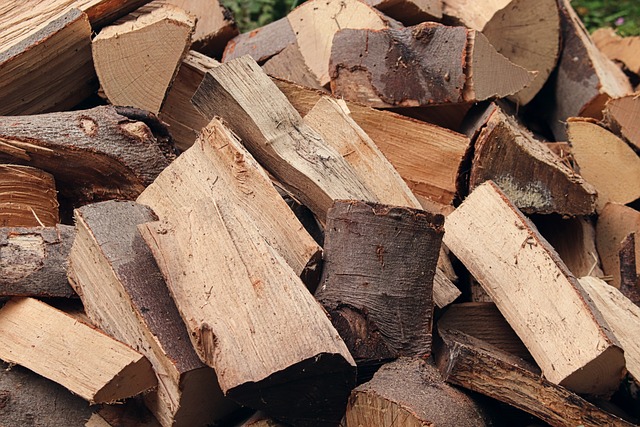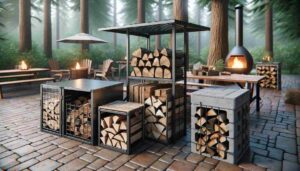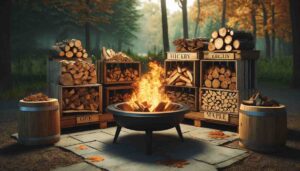When it comes to heating your home or enjoying a cozy evening by the fireplace, choosing the right firewood is essential. The choice between softwood and hardwood can have a significant impact on your overall experience, from the warmth and ambiance of the fire to the efficiency and maintenance of your heating system. In this article, we will explore the differences between softwood and hardwood firewood, their various uses, and tips for selecting, storing, and using them effectively.
Understanding Softwood and Hardwood
Before delving into the factors that influence your choice of firewood, it’s essential to understand what softwood and hardwood are and how they differ.
Softwood
Softwood comes from coniferous trees, which are typically evergreen and have needle-like leaves. These trees grow faster than hardwood trees and have a higher resin content. Softwood is often less dense and lighter in weight compared to hardwood, making it easier to split and ignite. Some common examples of softwood species used for firewood include pine, spruce, fir, cedar, and hemlock.
Hardwood
Hardwood, on the other hand, is derived from deciduous trees, which have broad leaves and generally grow more slowly than softwood trees. Hardwood is denser and heavier than softwood, which gives it several distinct advantages as firewood. Common hardwood species used for firewood include oak, maple, hickory, cherry, and birch.
Heat Output and Efficiency
One of the most crucial factors to consider when choosing between softwood and hardwood firewood is their heat output and efficiency.
Softwood
Softwood tends to burn faster and produce a more intense flame compared to hardwood. It ignites easily due to its lower density and higher resin content. While this makes softwood an excellent choice for kindling and getting a fire started quickly, it may not be the best option for long-lasting heat. The rapid combustion of softwood means you’ll need to add logs more frequently to maintain a consistent temperature.
Hardwood
Hardwood, with its higher density, burns slower and provides a steady, long-lasting source of heat. It generates a more sustained and even flame, making it ideal for heating your home efficiently. Hardwood firewood also produces less creosote, a flammable and sticky substance that can accumulate in your chimney, reducing the risk of chimney fires. Due to its energy density, you can use less hardwood compared to softwood to achieve the same amount of heat, ultimately saving you money and effort.
Flame Characteristics and Aesthetics
The type of firewood you choose can significantly impact the aesthetics and ambiance of your fire.
Softwood
Softwood tends to produce a crackling and popping fire with vibrant, dancing flames. It creates a bright, lively atmosphere that many people enjoy. The rapid combustion of softwood can result in a more dynamic visual display, making it an excellent choice for fireplaces and outdoor fire pits where the aesthetic aspect is crucial.
Hardwood
Hardwood offers a more subdued and steady flame. While it may not create the same lively spectacle as softwood, it provides a warm and cozy ambiance that is perfect for indoor heating during the colder months. The even burn of hardwood logs can also create less smoke and fewer sparks, making it a cleaner option for enclosed spaces.
Firewood Seasoning and Moisture Content
The moisture content of firewood plays a significant role in how well it burns and the heat it produces. Properly seasoned firewood is essential for an efficient and safe fire.
Softwood
Softwood typically has a higher moisture content compared to hardwood. This means that softwood logs need more time to dry and season properly before they are suitable for burning. Burning green or unseasoned wood can result in a smoky and less efficient fire, as a significant portion of the energy is wasted on evaporating the water within the wood. It can also lead to creosote buildup in your chimney.
Hardwood
Hardwood generally has a lower moisture content than softwood, making it easier to season and less prone to excessive smoking. Properly seasoned hardwood can have a moisture content of around 20% or less, while softwood may require a moisture content of 25% or lower for optimal burning. The lower moisture content of hardwood allows it to ignite more easily and produce cleaner, hotter fires.
Wood Splitting and Handling
Another consideration when choosing between softwood and hardwood firewood is the ease of splitting and handling the wood.
Softwood
Softwood is typically easier to split due to its lower density and lighter weight. This makes it an excellent choice for those who do not have access to heavy-duty splitting equipment. Softwood logs are also more manageable when it comes to transporting and stacking, as they are lighter and less bulky than hardwood logs.
Hardwood
Hardwood, being denser and heavier, can be more challenging to split, especially if you do not have the proper tools or experience. However, the effort required to split hardwood can be worth it for the superior heat output and efficiency it provides. If you have access to a log splitter or are willing to put in the extra work, hardwood can be a rewarding choice.
Resin and Aroma
The resin content of softwood can add a unique aroma to your fire, which may be desirable for some users.
Softwood
Softwood, such as pine and cedar, contains natural resins that can release a pleasant, aromatic scent when burned. The aromatic quality of softwood can enhance your overall fire experience, adding a fragrant and cozy element to your surroundings. This makes softwood a popular choice for outdoor campfires and wood stoves, where the aroma can contribute to the ambiance.
Hardwood
Hardwood generally lacks the strong, resinous aroma of softwood. While some hardwoods, like cherry and hickory, may impart a mild, sweet scent when burned, it is typically less pronounced compared to softwood. If you prefer a more subtle or neutral aroma when heating your home, hardwood may be the better choice.
Environmental Considerations
Environmental impact is an important factor to consider when selecting firewood. Sustainable practices can help ensure a steady supply of firewood for future generations.
Softwood
Softwood trees tend to grow more quickly than hardwood trees, making them a potentially more sustainable option if harvested responsibly. However, overharvesting or unsustainable logging practices can still deplete softwood resources and harm ecosystems. It’s crucial to source softwood firewood from reputable suppliers who practice sustainable forestry.
Hardwood
Hardwood trees generally grow more slowly and have a longer maturity cycle than softwood trees. This makes hardwood firewood potentially less sustainable if not managed correctly. To minimize the environmental impact, opt for hardwood firewood from well-managed forests or consider using hardwood scraps and offcuts from other industries, such as woodworking or furniture production.
Insect Infestations and Pest Control
Using firewood can introduce pests and insects into your home, which is a consideration when choosing your firewood type.
Softwood
Softwood is more susceptible to insect infestations due to its higher resin content, which can attract certain types of pests. It’s essential to inspect and store softwood firewood properly to prevent insects from making their way into your home.
Hardwood
Hardwood, with its lower resin content, is generally less attractive to pests and insects. However, it’s still important to inspect and store hardwood firewood correctly to minimize the risk of infestations. Proper storage and regular inspections can help ensure your firewood remains pest-free.
Common Uses for Softwood and Hardwood Firewood
The choice between softwood and hardwood firewood can also depend on the specific application and intended use.
Softwood
- Kindling: Softwood is excellent for starting fires due to its easy ignition and rapid combustion. Use softwood kindling to get your fire started quickly.
- Outdoor Fires: Softwood is a popular choice for outdoor fires, such as campfires and fire pits, where a lively flame and crackling sound are desired.
- Wood Stoves: Softwood can be used in wood stoves for heating, but it may require more frequent reloading due to its faster burn rate.
Hardwood
- Indoor Heating: Hardwood is the preferred choice for indoor heating, such as in wood-burning stoves and fireplaces, as it provides longer-lasting and more efficient heat.
- Cooking: Hardwood is often used for cooking, smoking, and grilling due to its clean and consistent burn, which imparts a desirable flavor to food.
- Long-Lasting Fires: Hardwood is ideal for situations where you want a fire to burn for an extended period without constant attention.
Tips for Selecting and Using Firewood
Now that you understand the differences between softwood and hardwood firewood, here are some essential tips for selecting, storing, and using firewood effectively:
1. Choose Properly Seasoned Wood:
- Regardless of whether you choose softwood or hardwood, always use properly seasoned firewood with a moisture content of around 20% or lower for efficient and clean burning.
2. Store Firewood Correctly:
- Store your firewood off the ground on a raised platform or pallet to prevent moisture absorption from the soil.
- Cover your firewood stack with a tarp or roof to protect it from rain and snow while allowing for proper airflow.
- Keep your firewood stack away from your home to minimize the risk of pests making their way indoors.
3. Rotate Your Firewood:
- Use a “first in, first out” system to ensure you are always burning the oldest wood in your stack, promoting proper seasoning and reducing waste.
4. Keep Firewood Dry:
- Avoid exposing your firewood to direct rain or snowfall. Wet wood is challenging to ignite and burns inefficiently.
- If you must burn slightly damp wood, mix it with well-seasoned dry wood to improve combustion.
5. Use the Right Tools:
- Invest in high-quality firewood splitting tools and safety gear when processing your firewood. Safety should always be a priority.
6. Maintain Your Fireplace or Stove:
- Regularly clean and inspect your fireplace or wood-burning stove, including the chimney, to ensure safe and efficient operation.
7. Practice Safety:
- Follow proper fire safety practices when using your fireplace or stove, including using a screen or glass doors to prevent sparks from escaping.
Conclusion
Choosing the right firewood, whether softwood or hardwood, can greatly impact your heating experience and the ambiance of your home. Softwood offers quick ignition and lively flames, making it suitable for outdoor fires and kindling. In contrast, hardwood provides long-lasting, efficient heat, making it ideal for indoor heating and cooking.
Ultimately, the choice between softwood and hardwood depends on your specific needs and preferences. Consider factors such as heat output, flame characteristics, moisture content, ease of handling, and environmental considerations when making your decision. By selecting and using firewood wisely and following best practices for storage and maintenance, you can enjoy safe, efficient, and enjoyable fires throughout the colder months.









